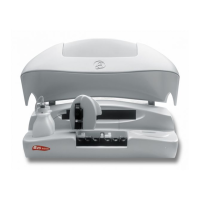11
(120 samples) to 5 racks of reagents (50 reagents) and 1 rack of samples (24 samples). Any reagent may be placed in
the fixed positions, but it is recommendable to use them for the bottles of distilled water, saline solution for the automatic
pre-dilutions and washing solution. The rack tray detects and identifies the type of racks. In this way, if the physical
disposition of the racks does not coincide with that programd on the computer, the analyzer alerts the user.
On the left of the analyzer are the waste and distilled water containers. The analyzer constantly controls the level of these
containers and issues the appropriate alerts if the distilled water is nearly empty or if the waste container is full.
1.1.3. Reactions rotor and reading
The preparations are dispensed in an optical quality methacrylate reactions rotor thermostatised at 37ºC. The optical
absorbance readings are taken directly on this rotor. Each reaction can be read for 15 minutes. The readings are taken
as they are programd in each measurement procedure. The reaction wells have been designed to enable the mixture of
the sample and the reagent during the dispensing. Each rotor has 120 reaction wells. The length of the light path is 6 mm.
The minimum volume required to take the optical reading is 200 L. The wells have a maximum useful capacity of 800 L.
When the reactions rotor is completely full, the user must change it with one that is empty, clean and dry. The reactions
rotors can be reused up to 5 times if they are carefully cleaned immediately after use. The Cleaning the semi-disposable
reactions rotor section in the User’s Manual describes how to clean the rotors. The user has a test in the computer
program, which he or she may use to check the condition of the rotor. The rotor is driven by a step-by-step motor with a
transmission. A Peltier system with PID control thermostatises the rotor at 37ºC.
An optical system integrated in the rotor takes the readings directly on the reaction wells. The light source is a 20 W
halogen lamp. The detector is a silicon photodiode. The wavelength is selected by a wheel with 9 positions available for
optic filters. The filters are easily changed by the user from the exterior of the analyzer, without the need for disassembling
the filter wheel. A step-by-step motor positions the wheel. The optical system is capable of taking 5 readings per second,
with or without a filter change in between. The light beam of the lamp passes through a compensated interferential filter
to select the desired wavelength and through focalisation lenses. It then passes through the rotor well and finally reaches
the photodiode, where the light signal is turned into an electric signal. A sophisticated analogical digital integrator-
converter system converts the electric signal into a digital value with which the analyzer obtains the absorbance values.

